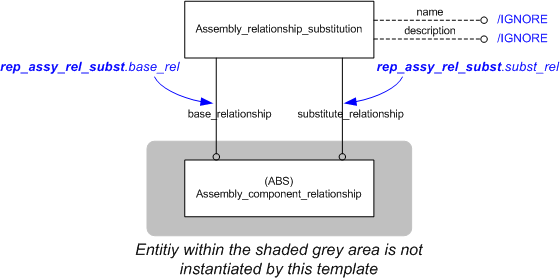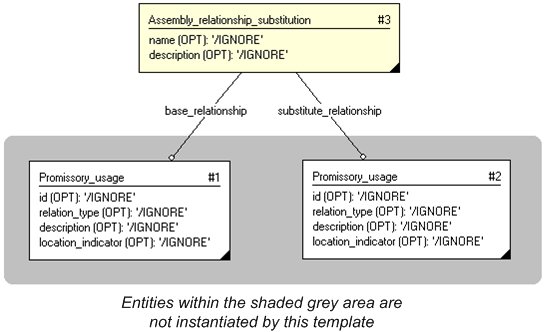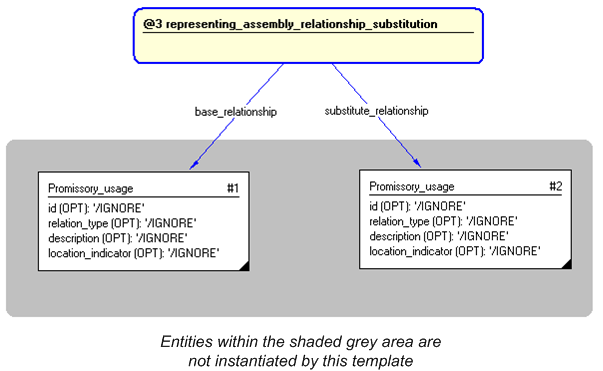Template:— representing_assembly_relationship_substitution (rep_assy_rel_subst)
Capability:representing_assembly_structure |
Date: 2010/08/26 07:37:38
Revision: 1.1
|
This section specifies the template representing_assembly_relationship_substitution.
NOTE
The template has been defined in the context of the capability
representing_assembly_structure
which provides an overall description of the
relevant parts of the ISO 10303-239 information model and a description
of related templates.
NOTE
An explanation of a template and the associated instantiation path is
provided in the
Template overview
section.
This template describes how to represent that a the usage of one Product_version can be substituted by the usage of another
Product_version in a specific assembly structure.
NOTE
Both assembly relationships shall refer to the same Product_view_definition of the same assembly.
NOTE
An Assembly_relationship_substitution defines a one-way substitution, i.e. if 'A' is specified as a substitute for 'B', 'B'
is not implied to be a substitute for 'A'.
The EXPRESS-G diagram in
Figure
1
shows the templates and EXPRESS entities that are required
to represent the template
"representing_assembly_relationship_substitution".
The text highlighted in blue shows the template parameters.
Figure 1 — An EXPRESS-G representation of the Information model for representing_assembly_relationship_substitution
The graphic for the template to be used in other EXPRESS-G diagrams
is shown in Figure
2
below.
Figure 2 — The graphical representation of the representing_assembly_relationship_substitution template
The following input parameters are defined for this template:
The following reference parameters are defined for this template:
%^target = $representing_assembly_relationship_substitution.assy_rel_subst%
The following parameter combinations specify a uniqueness constraint:
Unique constraint: Assembly relationship substitution
Each instance of the
entity
(
Assembly_relationship_substitution)
within the data set shall be uniquely identified
by a combination of the following parameters on this
template (representing_assembly_relationship_substitution) namely:
base_rel,
subst_rel.
The
instance is
referenced by the following template parameter:
assy_rel_subst.
The instantiation path shown below specifies the entities that are to be
instantiated by the template.
A description of templates and the syntax for the instantiation path is
provided in the
Templates Help/Information section.
The following entities are instantiated with attributes as specified:
The instance diagram in Figure
3
shows an example of the EXPRESS entities and templates that are instantiated by the template:
/representing_assembly_relationship_substitution(base_rel='#1', subst_rel='#2')/
(an illustration of the consolidated representing_assembly_relationship_substitution template is shown in
Figure
4 below.)
Figure 3 — Entities instantiated by representing_assembly_relationship_substitution template
The instance model in STEP ASCII exchange file format (ISO 10303 Part
21 syntax) is:
#1 = PROMISSORY_USAGE('/IGNORE','/IGNORE','/IGNORE',$,$,$,'/IGNORE');
#2 = PROMISSORY_USAGE('/IGNORE','/IGNORE','/IGNORE',$,$,$,'/IGNORE');
#3 = ASSEMBLY_RELATIONSHIP_SUBSTITUTION('/IGNORE','/IGNORE',#1,#2);
The instance model in STEP XML exchange file format (ISO 10303 Part
28 ed.2 syntax) is:
The instance diagram in
Figure
4
shows the graphic symbol for the template that is to be
used in other instance diagrams. The example template is:
/representing_assembly_relationship_substitution(base_rel='#1', subst_rel='#2')/
Figure 4 — Instantiation of representing_assembly_relationship_substitution template
Characterizations
No common characterizations of the template
representing_assembly_relationship_substitution
have been identified. However, the ISO 10303-239 EXPRESS model
may enable other assignments to the entities instantiated by the template.




